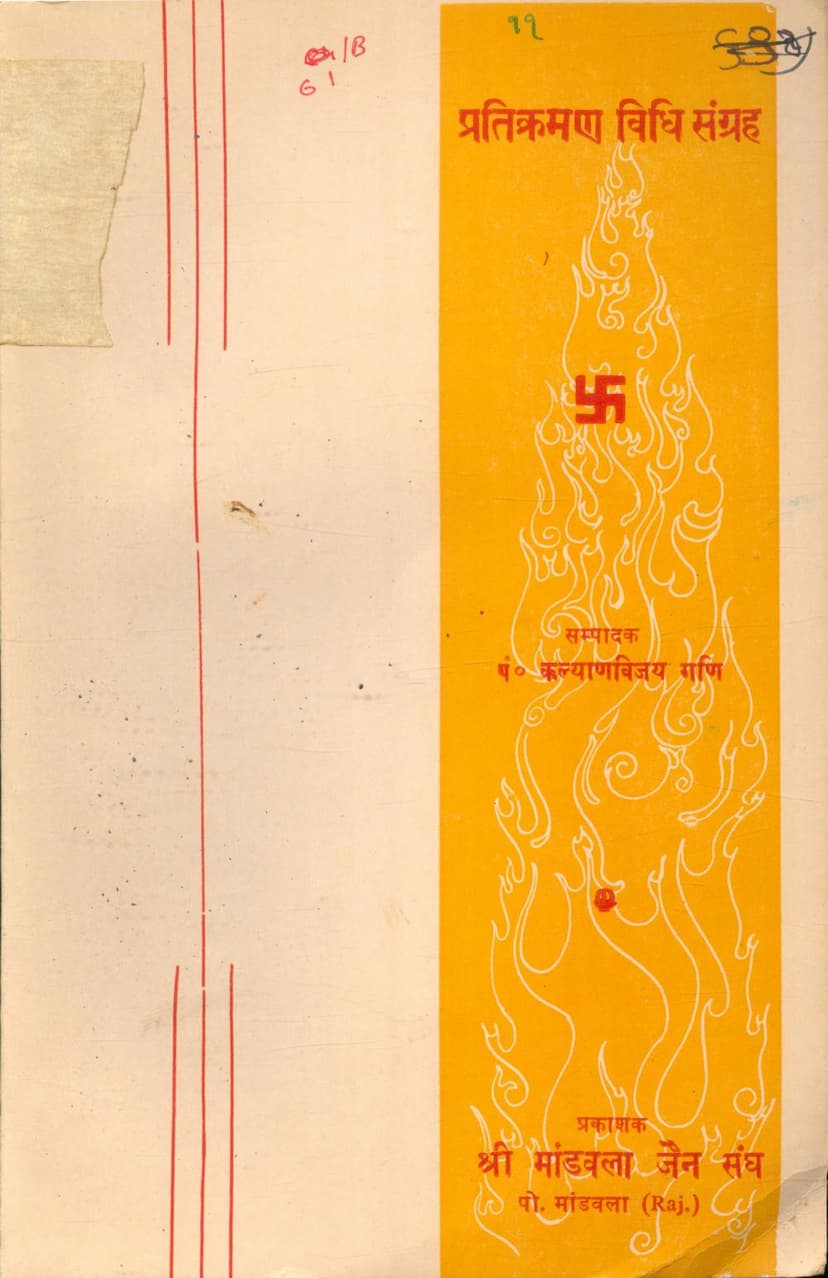Pratikraman Vidhi Sangraha
Added to library: September 2, 2025

Summary
Here's a comprehensive summary of the Jain text "Pratikraman Vidhi Sangraha" by Kalyanvijay Gani, based on the provided pages:
The book, "Pratikraman Vidhi Sangraha" (Collection of Procedures for Pratikraman), published by Shri Mandavala Jain Sangh and edited by Pandit Kalyanvijay Gani, serves as a compilation of various methods and rituals related to Pratikraman, a significant practice in Jainism. The text delves into the historical and philosophical aspects of Pratikraman, detailing its importance, procedures, and variations across different Jain traditions and historical periods.
Key Themes and Content:
-
Definition and Importance of Pratikraman: The book begins by defining Pratikraman as a crucial part of the "Aavashyak" (Necessary Duties) in Jainism. It emphasizes that Pratikraman is so central that sometimes the entire set of six Aavashyaks is referred to by this name. The term "Aavashyak" itself signifies something that is essential and must be performed by both monks (Shravaka) and laypeople (Shravaka) at the end of the day and night. Pratikraman, in its essence, means returning to one's own righteous path or duty after straying due to negligence or error.
-
Historical Context and Evolution: The text discusses the evolution of Pratikraman practices, noting the differences between the time of Lord Mahavir (Jin-kaal), the time of Elder monks (Sthavir-kaal), and the present day. It acknowledges the difficulty in precisely replicating ancient practices due to vast changes in time, place, and social conditions. The influence of geography and time on Jain rituals and observances is highlighted, comparing it to the evolution of scripts and languages from ancient Prakrit languages to modern Indian languages.
-
Sources and Authorities: The book draws upon various Jain scriptures and commentaries, including:
- Aavashyak Churni: Mentioned as a key source for monk's Pratikraman, dating back to the late 6th century CE.
- Haribhadra Suri's Panchvastuk: Another source for monk's Pratikraman.
- Shradh Pratikraman Sutra: A significant text for laypeople's Pratikraman, with commentary by Acharya Jayasingh Suri and annotation by Shri Parshva Rishisuri. It notes that such detailed lay Pratikraman procedures are not found in earlier scriptures.
- Various Gachhas (Sects): The text discusses the Pratikraman samacharai (practices) prevalent in different Gachhas, such as the Achal Gachha, Kharatar Gachha, and their branches, noting variations and historical divergences in their practices.
-
Procedures for Pratikraman: The book outlines the specific steps and rituals involved in Pratikraman, categorized into different types:
- Daivasik Pratikraman (Daily Pratikraman): This covers the procedures performed daily, typically after sunset. It details the cleansing of the area, the setup of the Pratikraman mandali (group formation), the performance of various steps like Samayika, observing the time, reciting specific verses, introspection on daily transgressions, apologizing, and performing Kayotsarga (meditative standing).
- Raatrik Pratikraman (Nightly Pratikraman): Procedures for the night, involving similar elements of introspection and repentance, adapted for the night-time context.
- Paakshik Pratikraman (Fortnightly Pratikraman): This involves confessing and repenting for transgressions committed over a fortnight. It includes specific procedures for seeking forgiveness from seniors and fellow monks.
- Chaaturmaasik Pratikraman (Four-monthly Pratikraman): A more extensive ritual covering the transgressions of a four-month period.
- Saamvatsarik Pratikraman (Annual Pratikraman): The most comprehensive ritual, covering transgressions over an entire year, often coinciding with the Paryushana festival. It involves significant introspective practices and seeking forgiveness.
-
Kayotsarga and its Significance: Kayotsarga is a central element in Pratikraman. The book explains its various forms and purposes, including purification of conduct (Charitra), purification of faith (Darshan), and purification of knowledge (Gyan). The duration of Kayotsarga is often measured in breaths (shwasochhwas) and involves contemplating specific verses or deities.
-
Specific Rituals and Elements:
- Mukhapatti (Mouth-cloth): The importance of cleaning and attending to the Mukhapatti, a symbolic cloth worn by monks, is frequently mentioned.
- Rajoharan (Broom): The ritualistic cleaning with the Rajoharan is also a part of the procedures.
- Vandan (Salutations): Various forms of salutations to Gurus, deities, and fellow monks are integral to seeking forgiveness and showing respect.
- Kshamapan (Seeking Forgiveness): The core of Pratikraman is seeking forgiveness for committed faults (Atichara). This is done through confession, repentance, and seeking absolution from the Guru and fellow practitioners.
- Prashchitta (Penance): The text mentions that specific penances are prescribed for different transgressions.
- Mantras and Stotras: Recitation of specific mantras and stotras, such as the "Chaturvimsatistav" (praise of 24 Tirthankaras), "Lokass Ujjotagare," "Siddhastav," and various "stutis" (praises) is a key component.
- Tapa (Austerities): The contemplation and commitment to undertaking specific austerities as part of penance are also discussed.
-
Layperson's Pratikraman (Shradh Pratikraman): The book dedicates significant attention to the Pratikraman procedures for lay followers, emphasizing that while the essence is the same, certain practices are adapted for their lifestyle. This includes the importance of humility, seeking forgiveness from elders, and the specific structure of their communal prayers and repentance.
-
Concluding Remarks: The book emphasizes the profound spiritual benefits of Pratikraman, including purification of the self, removal of karmic obstacles, and spiritual upliftment, ultimately leading towards liberation.
In essence, "Pratikraman Vidhi Sangraha" is a detailed guide to a fundamental Jain ritual, offering insights into its theological underpinnings, historical development, and practical execution, serving as a valuable resource for understanding and performing this essential spiritual discipline.